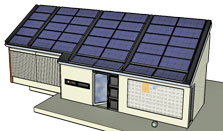

The MIT home was designed after analyzing all past Solar Decathlon homes and a series of six solar homes built at the university beginning in the 1930s. A translucent Trombe wall provides an attractive facade while passively capturing solar heat energy.
Download Construction Drawings
(Zip 4 MB)
Neither the United States, nor the Department of Energy, nor the Alliance for Sustainable Energy LLC, nor any of their contractors, subcontractors, or their employees make any warranty, express or implied, or assume any legal liability or responsibility for the accuracy, completeness, or usefulness for any purpose of any technical resources or data attached or otherwise presented here as reference material.
Solar Decathlon 2007
Massachusetts Institute of Technology
Team Web site: mit.edu/solardecathlon/
Learning from the Past
Mens et manus — mind and hand. From adopting their historic university motto as a guiding philosophy to exercising the engineering institution's penchant for analysis, the MIT team incorporated their history, culture, and setting into their Decathlon house.
An MIT architecture class reviewed and analyzed all the 2002 and 2005 Solar Decathlon entries. Determining that the 2002 heat wave is more likely than the 2005 rainstorms, the team designed with the assumption of at least one sunny day for the week. In this spirit, the team sought to make minimization statements wherever possible—employing an efficient solar array, a small battery footprint, complete waste mitigation, and maximum use of passive solar design.
Although this is MIT's first Decathlon entry, it is by no means its first solar home. The team refers to the home as "Solar 7," because MIT has built six solar homes in the past, going back to the 1930s. Studying the history of these homes helped inspire the new home's primary technological feature, which is an innovative use of solar thermal systems. Passive solar thermal energy storage was a key feature in one of the historic homes. The new MIT Decathlon entry features a Trombe wall of translucent tiles that are used to passively convert sunlight into stored heat.
If you cannot make it to Washington, D.C., for the Solar Decathlon, you can still tour the MIT home on the virtual reality Web site secondlife.com. Another high-tech feature to help explain the home to visitors is a touchscreen computer coffee table that interfaces with software controls for the home's utility systems.
Graduate student Corey Fucetola speaks for himself and his teammates in summing up the Solar Decathlon experience. "It is a powerful opportunity to engineer, design, build, and finance the creation of an energy-efficient home," he says.
Team Contact
Kurt Keville
kkeville@mit.edu
